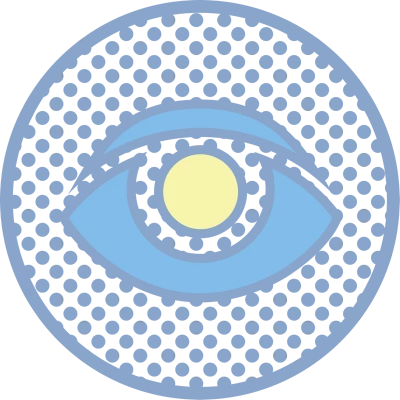What is Uveitis Eye?
The uvea is the middle layer of the eye which contains much of the eye’s blood vessels. It is located between the sclera, the eye’s white outer coat, and the inner layer of the eye called the retina and is further made up of the iris, ciliary body, and choroid.
Uveitis encompasses a group of inflammatory diseases that produces swelling of the uveal tissues. It is not necessarily limited to the uvea but can also affect the lens, retina, optic nerve, and vitreous, producing reduced vision or blindness.
Uveitis may be caused by problems or diseases occurring in the eye, or it can be part of an inflammatory disease affecting other parts of the body.
It can happen at all ages and primarily affects people between 20-60 years old.
Uveitis can last for a short (acute) or a long (chronic) time. The severest forms of uveitis can reoccur many times.
What are the Symptoms of Uveitis Eye?
Uveitis can affect one or both eyes simultaneously. Symptoms may develop rapidly and can include:
-
Blurred vision
-
Dark, floating spots/lines in the vision (floaters)
-
Eye pain
-
Redness of the eye
-
Sensitivity to light (photophobia)
The signs and symptoms of uveitis depend on the type of inflammation.
Acute anterior uveitis may occur in one or both eyes and in adults is characterized by eye pain, blurred vision, sensitivity to light and redness.
Intermediate uveitis causes blurred vision and floaters. Usually, it is not associated with pain.
Posterior uveitis can produce vision loss. This type of uveitis can only be detected during an eye examination.

What are the Causes of Uveitis Eye?
Inflammation is the body’s natural response to tissue damage, germs, or toxins. It produces swelling, redness, and heat and destroys tissues as certain white blood cells rush to the affected part of the body to contain or eliminate the insult. Any inflammation of the uveal tissue produces Uveitis.
Uveitis may be caused by:
-
An attack from the body’s own immune system (autoimmunity)
-
Infections or tumors occurring within the eye or in other parts of the body
-
Trauma to the eye
-
Drugs and toxins
-
Most of the times the cause remains unknown which is termed as idiopathic
What are the types of Uveitis?
The type of uveitis can classified by where inflammation occurs in the uvea:
-
Anterior uveitis is inflammation of the iris (iritis) or the iris and ciliary body.
-
Intermediate uveitis is inflammation of the ciliary body.
-
Posterior uveitis is inflammation of the choroid.
-
Diffuse uveitis (also called pan-uveitis) is inflammation of all parts of the uvea.
How do doctors/surgeons diagnose Uveitis Eye?
Diagnosis of uveitis includes a thorough patient’s medical history and a detailed examination of the eye to record the findings.
Further ancillary investigations , laboratory tests may be done to rule out an infection or an autoimmune disorder.
Eye examination includes
An Eye Chart or Visual Acuity Test: This test measures whether a patient’s vision has decreased.
Ocular Pressure: Intraocular pressure (IOP) is the fluid pressure of the eye. As pressure is a measure of force per area
A Slit Lamp Exam: A slit lamp noninvasively inspects the front and back parts of the eye
A Dilated Fundus Examination: The pupil is widened (dilated) with eye drops, and then a light is shown through with an instrument called an ophthalmoscope to noninvasively inspect the back, inside part of the eye.
What are the complications of Uveitis?
Many cases of uveitis are chronic, and they can produce numerous possible complications, including clouding of the cornea, cataracts, elevated eye pressure (IOP), glaucoma, swelling of the retina or retinal detachment. These complications can result in permanent vision loss.
What’s the treatment for Uveitis?
The goal of treatment in uveitis is to eliminate inflammation, alleviate pain, prevent further tissue damage, and restore any loss of vision.
If uveitis is caused by an underlying condition, treatment will focus on that specific condition.
The first option for uveitis treatment is to seek help from drugs that reduce inflammation. Your doctor may first prescribe eyedrops with anti-inflammatory medication, such as a corticosteroid. If those don’t help, a corticosteroid tablets or injection may be the next step.
The second option for uveitis treatment is getting relief from drugs that fight bacteria or viruses. If uveitis is caused by an infection, your doctor may prescribe antibiotics, antiviral medications or other medicines, with or without corticosteroids, to bring the infection under control.
Drugs that affect the immune system or destroy cells. You may need immunosuppressive or cytotoxic drugs for uveitis treatment if the disease does not affect both eyes, doesn’t respond well to corticosteroids or becomes severe enough to threaten your vision.
Surgical and other procedures
Vitrectomy. Surgery to remove some of the vitreous in your eye (vitrectomy) may be necessary to manage the condition.
Surgery that implants a device into the eye to provide a slow and sustained release of a medication. For people with difficult-to-treat posterior uveitis, a device that’s implanted in the eye may be an option. This device slowly releases corticosteroid medication into the eye for two to three years. Possible side effects of this treatment include cataracts and glaucoma.
Anterior Uveitis treatments
Anterior uveitis may be treated by:
-
Taking eye drops that dilate the pupil to prevent muscle spasms in the iris and ciliary body (see diagram)
-
Taking eye drops containing steroids, such as prednisone, to reduce inflammation
-
Intermediate
-
Posterior
-
Panuveitis treatments
Intermediate, posterior, and panuveitis are often treated with injections around the eye, medications given by mouth, or, in some instances, time-release capsules that are surgically implanted inside the eye. Other immunosuppressive agents may be given. A doctor must make sure a patient is not fighting an infection before proceeding with these therapies.
Some of these medications can have serious side effects, such as glaucoma and cataracts. You may need to visit your doctor for follow-up examinations and blood tests every 1 to 3 months.
Written by: Dr. Karpagam – Chairman, Education Committee
Frequently Asked Questions (FAQs) about Uveitis
What is acute anterior uveitis?
In simple terms, anterior uveitis refers to the inflammation of the centre or middle layer of the patient’s eye. This layer includes the colored part of the eye, also called an iris, along with an adjacent tissue called the ciliary body. Blurred vision, sensitivity to light, inflammation of the eye, soreness, redness, and abnormally shaped pupil are some of the many symptoms of acute anterior uveitis.
Further, there are several causes and risk factors of acute anterior uveitis. Often, it results from some kind of trauma caused to the eye, like being hit by something hard or having a foreign body enter the eye. In addition, it can also be associated with health problems like tuberculosis, rheumatoid arthritis, viral infections, sarcoid, and more.
What is chronic uveitis?
Chronic uveitis refers to a medical condition where the inflammation of the eye lasts for about six weeks or more. On the other hand, in the case of chronic uveitis. There is a chance that even after receiving proper treatment, the condition resurfaces after a gap of 2.5-3 months.
Usually, when uveitis reaches this chronic stage, it gets very uncomfortable to the extent that it significantly impacts the vision of the person. If treated in time, chronic uveitis can lead to vision loss.
What is the difference between posterior uveitis, anterior uveitis, and intermediate uveitis?
When a disease is divided into more than two types or categories, there is a high chance that the condition affects different parts of the organ. Since there 3 types of uveitis, we have given a short overview into each one of them.
- Posterior uveitis: This type of uveitis affects the choroid and the retina at the back of the eye.
- Anterior uveitis: This is the most common type of uveitis, which directly impacts the iris of the eye.
- Intermediate uveitis: This type of uveitis has an impact on the vitreous gel and the ciliary body of the eye.
What is iridocyclitis treatment?
Iridocyclitis treatment, also known as eye iritis treatment, relieves inflammation and pain while preserving vision at the same time. Usually, iridocyclitis or iritis treatment involves the following:
- Dilating Eyedrops: In the first option for treatment for iritis, your ophthalmologist uses special eyedrops to dilate the pupil, which can reduce iritis pain. Dilation of pupils can also ensure protection from developing severe complications that interfere with the functions of the pupil.
Steroid Eyedrops: Your ophthalmologist suggests glucocorticoid medications that are usually given in the form of eye drops to reduce inflammation of the iritis.

Do not ignore eye trouble!
Now you can reach our senior doctors by booking an online video consultation or a hospital appointment
Book an appointment now